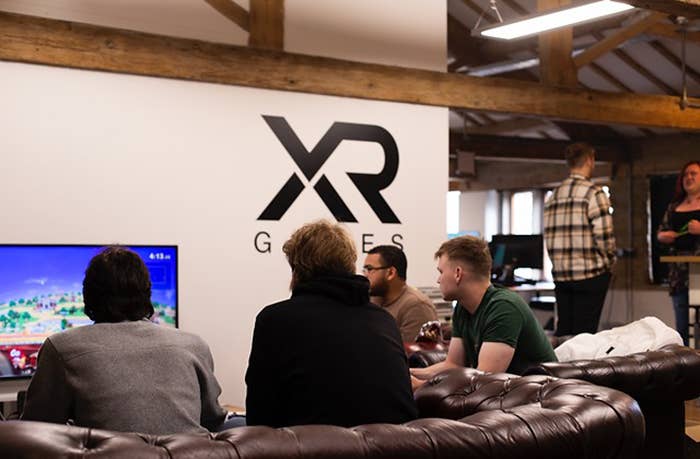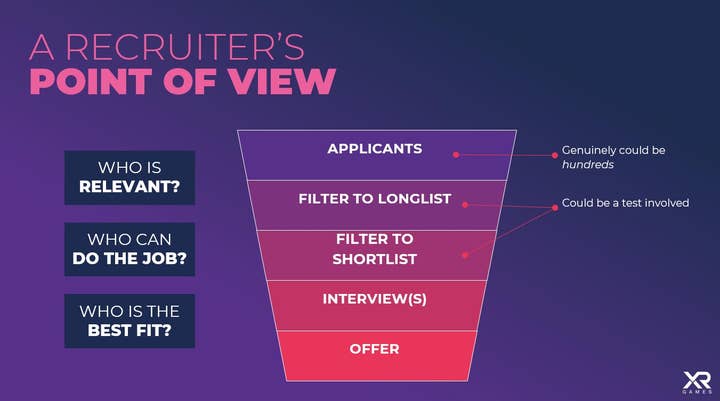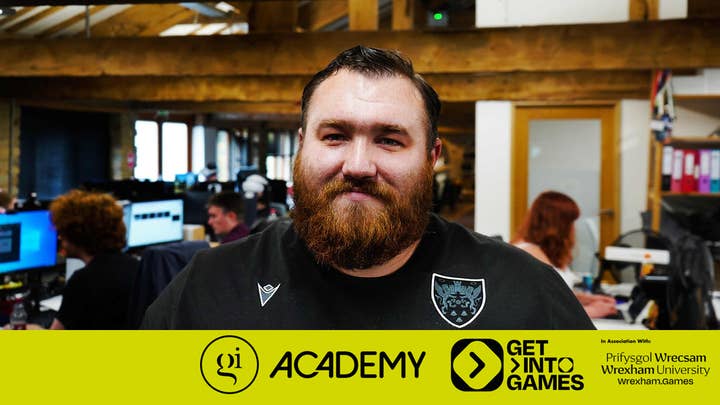Everything you need to know about applying for your first job in game development
XR Games' Andy Driver shares his dos and don'ts for kicking off your career
This article is part of our Get into Games special, offering students insight on life in the games industry and advice on how to get into the business. You can also find aselection of the best Academy guides for job-seekers here
Working in game development is a dream for many people around the world. It's a hugely popular form of entertainment that sees developers working on the cutting edge of both art and science.
At EGX 2023, XR Games' talent acquisition manager Andy Driver shared his tips on how to land your first job in game development.
But first, he kicked off by providinga much-needed reality check – that it is really hard to score a position in the sector, adding that having a strong skillset is only half the battle. You might not land your dream job straight away, but your career is a journey that needs to be taken step by step.
It's also important to have other interests outside of your game development studies; these will likely be essential in landing your first job.
Getting a job isn't simple
Applying for a job in games isn't a trivial matter of sending someone your CV and hoping for the best. There are a few different stages that you need to go through to land a position; you first need to find a role you want to apply to. These can be found on job boards, websites, social media platforms and LinkedIn.
"You'll then apply for those jobs and go through whatever application process each studio has," Driver said.
"Chances are you won't hear back from most of them. You'll almost certainly won't get feedback at that stage either, just to manage expectations. Applying for a job and being rejected without doing any interviews or talks, you probably won't get feedback."
There are hundreds of people applying for each position, so companies hiring cannot provide feedback to everyone who applies. But after that initial stage, you may be invited for an interview or a test – depending on the position. There might be multiple stages to the process.
"That depends on the studio," Driver said. "Then you'll get an offer. That seems straightforward; just follow those steps.
"The problem is that sometimes you'll get all the way through; you'll apply for jobs, you won't get anything, you won't hear back from any of them. So then you have to go find more jobs to apply for."
He continued: "It could be you get all the way to an interview and the feedback says we're not hiring you for this reason. You might have to go back to the beginning and say: 'Well, I need to work on something skills-wise. I need to develop this. I need to show more of this'."
The point that Driver is trying to drive through is that applying for jobs is not a straightforward and linear process.
"The reality will be vastly different," he explained. "It is going to be messy and it is going to be up to you to be organised and keep on top of everything to understand where you're at with everything, taking feedback and taking learnings on board throughout the whole time."
What do I need?
There are several important elements of a job application, include your CV and portfolios, and the discipline you're looking to specialise in (such as artist, designer or programmer) also introduces certain considerations you need to factor in.
CV
This should go without saying, but you will need a CV in order to apply for a job.
Through this, you'll show your experience and education, but also provide an idea of who you are as a person and whether a company wants to hire you.
"[Your CV should] show you're not a development robot; we hire people"
"Your CV provides the bulk of conversation when you get to an interview," Driver explained.
"Most of the time, you'll be asked about a project, what you did, what challenges you faced and how you overcame them. Your CV might also have a load of personal details about you – your hobbies, your interests and so on. It could be what you want to do as a job or what your intended career path is.
"What this does is make you a real person and give you a personality. It shows you're not a game development robot; we hire people."
You can check out the GamesIndustry.biz Academy guide to improving your CV right here.
Portfolios
When applying for entry or junior roles, you will need a portfolio.
"That is the thing that gets you the interview," Driver said. "But having a great portfolio does not get you a job. It might get you an interview, but it won't get you a job."
A great portfolio needs to get the basics right; you need to ensure that you:
- Have a working URL for your portfolio
- Ensure that it is easily visible on your CV/application
- Have a simple layout - consider how the user will experience it
- Try to reduce adverts and distractions
- Get to the point
- Never password-protect your portfolio
You can read more about how to put together a winning portfolio in our handy GamesIndustry.biz Academy guide.

Advice for artists
Those going for art roles in the games industry just need to use ArtStation for their portfolios, as this streamlines the process massively. For these kinds of roles, it's vital that applicants showcase actual game art; this can be in-engine images or gameplay screenshots.
It will also help to show your process, highlight your research and show how and why you made the decisions that you made.
It's vital to focus on quality over quantity; you don't need to feature everything but rather highlight who you are as an artist at this point in time.
That being said, variety will likely help you land a job – show off what you can do. Be original and creative. You should also provide descriptions and explain how you did your work. Say what tools you used, what engine the art was created in, what timeframe you completed the work in and what specifications you had for the project.
Finally, artists shouldn't compare their portfolios to their classmates, but they can look at the work of their peers for examples of what to display.
Advice for designers
As with artists, designers don't need to create a website from scratch for their portfolios. They can use templated platforms, such as Wix, WordPress and Squarespace, to save time.
Designer portfolios should focus on the games that they themselves have made rather than analysing the work and games of other developers. It's also important to show something that the recruiter can play as this will give them an idea of your skillset.
"[Applying for jobs] is going to be messy and it is going to be up to you to be organised, taking feedback and taking learnings on board throughout the whole time"
You should make your portfolio visually appealing; have gameplay videos, screenshots and work-in-progress pictures. It's also vital to show off your documentation abilities; within this skillset, ideally, you should balance detail with conciseness.
Finally, you need to let the reader know how big the team was on each project and specify what your role within this was.
"I'm only interested in what you did," Driver said.
Advice for programmers
Portfolios are absolutely essential for programmers. It's not enough to just send over some code samples on Github; you need to provide something visual and highlight examples that are relevant to game development.
Ideally, programmers should have a completed game that can be downloaded and played through.
"That's really the very best thing for portfolios," Driver explained. "Show me something I can play with and interact with."
You should also embed video playthroughs, images and gifs into your portfolio to help give an idea of your skillset. Any description you provide in your portfolio should be clear and concise; recruiters need to know every single detail about the project, such as what language, engine and tools you have used and how long it took you to complete the work.
For some studios, providing code samples will be important; for others, it won't be. Some developers will set a coding challenge straightway to get an idea of your abilities, while others won't give you a coding test and will instead focus on the code samples provided. It's best to play it safe and provide code so that if recruiters want to see if you have chops, they can. Driver recommends hosting these samples on GitHub.
"The best way to present it would be: 'Here's the game I made, here are some screenshots of it, here's the language and engine, here's what I did, and here's a hyperlink to go look at the code if you want to go look at the code'," he explained.
"That's the best way to present a programming portfolio. They should always compliment the visual aspects of your portfolio."
Have good communication and interview skills
So you've dazzled a recruiter or company with your skills, experience and know-how; now you'll likely be invited for an interview.
At this point in the process, it's vital for you to show that you can communicate and get on with other people.
"What this does is it shows you can fit in with the team," Driver said.
"It shows that you are able to talk to people, you are going to be able to work with people. Game development is a team sport; you don't do it entirely alone when you work in a studio. You work with other people."
Again, the GamesIndustry.biz Academy has a guide on how to succeed at a job interview, as well as how not to ruin it.
Be sure to have the whole package
You need to have all of the above in order to land a position. Driver emphasises that no individual component or aspect of this process will be enough to guarantee you a job.
If you have an amazing portfolio, but your CV or interview skills are lacking, you won't be hired. If you have great communication skills, but your portfolio and CV aren't great, you won't get to the interview stage.
"It's a combination of every single thing," Driver said. "Don't feel that one of them is more important than the other. The big one people leave off is the bit about them – they don't feel it's important, but it's super relevant. It'll help the interview to go well. It'll give you something to talk about.
"I guarantee that for every single interview you do, the interviewer will be looking at your CV. That will form the small talk. It makes you a real person and shows that you could fit within the team. That's important."

The jobs funnel
To help highlight what the hiring process looks like, Driver shared what he called the 'jobs funnel.'
"At the start, you have applicants," he said."You could genuinely have hundreds of them. Last year, we hired some junior game designers. We needed to hire four and our job ad attracted 18,000 applications. That's not uncommon and we're only a smallish studio."
So, recruiters need to find a way to bring that long list of applicants down to something manageable.
"Becoming a real person and communicating clearly... [is] how you turn that interview into us hiring you"
"What I am asking is who from this list of people is relevant," Driver said. "It's taking out people who haven't got a portfolio or have a portfolio with nothing to do with game development on it. All those people are filtered out at that stage. You have not shown me anything to show me you are relevant for this job.
"Once we get past that, what I am then looking for is which of these people who are relevant can technically do the job. That's where the task or test might be so that by the time we get to interview, I know that on paper, technically, you know how to use the right tools, you know how to use the right software, you know what the job is. I technically could give you the job right now and you could do it."
The final stage of the recruitment process is figuring out which of the people who can technically do the job is the right person to hire.
"The final question we're asking is who is the best fit," Driver said. "If there are five, six, seven people at the interview stage and we only have one spot… All of them technically can do the job and they all have pretty similar experience with junior roles. What we're then looking at is who the best person to fit in our team is. That's where becoming a real person and being able to communicate really come into play.
"It's how you turn that interview into us hiring you."
This article is part of our Get into Games special. You can find more talks and panels via the video links here, and a selection of the best Academy guides for job-seekers here.

